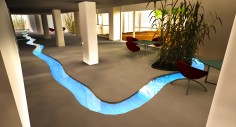Stéphane Thidet
Le Ruisseau
source: aajpresswordpress
Stéphane Thidet, Le Ruisseau. For the Hôpital Jean Jaurès in Paris, the Director, Thibaut Tenailleau, and the staff wanted a symbolic aspect to improve the reception areas. Stéphane Thidet’s project Le Ruisseau (The Brook) is a glass covered, underfloor watercourse, with various meandering routes to suggest fountains, waterfalls, and irrigation for plantations. The artwork brought the ‘outside -inside’ through the notion of flux – a conducting line or ‘thread’ through the flow of patients, visitors, staff working on site connecting the different parts of the site and enabling staff and visitors,“ to have a free access to art with their own sensibilities”.
.
.
.
.
.
.
.
source: thewildmagazine
Stéphane Thidet is a French artist who takes regular, everyday objects and transforms them into absurd, fantastical, slightly disorienting installation pieces. Although his work may be slightly off-putting at first, Thidet’s consistently humorous touch lends his installations a sense of accessibility and charm. Thidet is a multimedia contemporary artist, who apart from installations, also works in photography, video and sculpture. Many of his pieces were inspired by toys or games from childhood and play with ideas in popular culture and entertainment.
Much of his work also tests our limits of what we deem normal or the traditional use of an object, transforming the mundane into the frustrating and enchanting. For example, Thidet’s billiard table sculpture which he created for an art exhibition titled Ceci n’est pas un casino at the Casino Luxembourg in France. The table, Sans titre (Je veux dire qu’il pourrait très bien exister, théoriquement, au milieu de cette table […]) features it’s very own green felt mountain range in the center, making it totally unplayable, or, at least, much more challenging.
Thidet said of his work, “I want people to move from the object to the idea of place – and hence the way in which it is lived in – the situations of inaccessibility, of exclusion that I bring about are part of a tension that I am looking for… Ultimately, I create situations that fail to deliver their promise. While I don’t especially try to make my work popular, the signs that I use belong to a collective memory. I was definitely influenced by Lewis Carroll proposing a maladjusted, twisted, or even aggressive and dangerous reality.” Thidet’s subversive installations are as thought-provoking as they are tongue-in-cheek. His art is a fun, imaginative alternative to reality, inviting viewers to step into the warped collective consciousness of Thidet’s world.
.
.
.
.
.
.
.
source: alinevidal
Stéphane Thidet se sert des paradoxes tels que le jeu et le rite, le manque et le doute, l’inquiétante familiarité, le renversement des données temporelles.
La deuxième exposition personnelle à la galerie de Stéphane Thidet articule ses dernières pièces en explorant la mise en péril comme champs des possibles. Les œuvres conçues pour l’exposition proposent de penser le déclin non comme une amorce de la fin, mais comme une alternative d’existence de ce qui nous entoure : Figer, fragiliser, éplucher, forcer les choses à se tourner vers une nouvelle origine, supposer leur condition d’existence.
Objets auto-piégés, situations de coma infligées aux objets : cette mise en perspective propose un monde altéré, et crée une lecture fictionnelle de notre quotidien.


